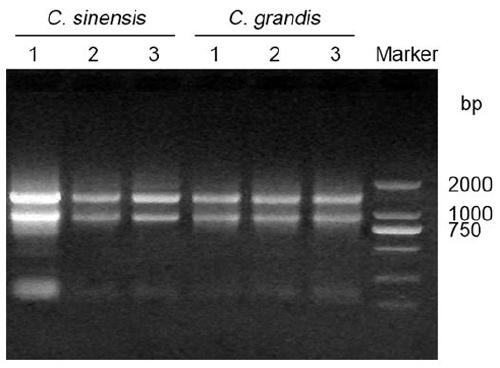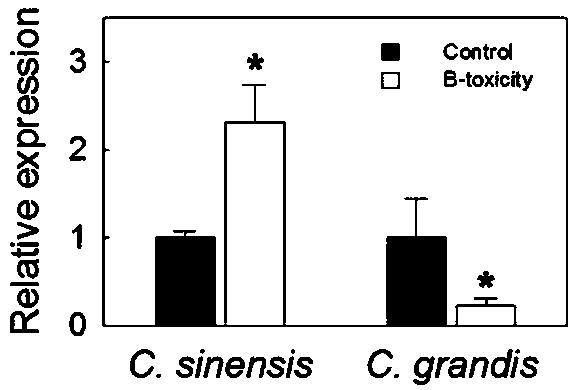Citrus laccase family gene CsiLAC4 and application thereof
A technology of citrus and laccase, which is applied in the fields of application, genetic engineering, plant genetic improvement, etc., can solve the problems that have not been reported yet, and achieve the effect of improving boron toxicity resistance, good development status, and improving plant boron toxicity resistance
- Summary
- Abstract
- Description
- Claims
- Application Information
AI Technical Summary
Problems solved by technology
Method used
Image
Examples
Embodiment 1
[0036] Embodiment 1 citrus laccase family gene CsiLAC4 Cloning of full-length cDNA
[0037] Citrus laccase family genes CsiLAC4 Primer premier 5 .0 was used to design primers for the gene sequence of citrus, and its full-length was amplified from Citrus citrus by combining RT-PCR and nested PCR. The detailed steps are as follows:
[0038] The materials are the seedlings of 'Snow Orange' planted in the Citrus Greenhouse of the Institute of Pomology, Fujian Academy of Agricultural Sciences, with a seedling age of 11 weeks. After adding 400 μM boric acid Hoagland's nutrient solution every other day for 15 weeks of boron poisoning treatment, take the 20th - 25th adult leaves above the base (1 / 3 of the plant height), and immediately freeze them with liquid nitrogen . Total RNA was extracted by TRIzol method, the specific method is as follows:
[0039] Preparation before the experiment: use 10% (v / v) DEPC water to treat all kinds of pipette tips, centrifuge tubes, mortars and p...
Embodiment 2
[0057] Under the long-term boron poisoning stress of embodiment 2 CsiLAC4 qRT-PCR analysis of genes and their relationship with cell wall secondary metabolism
[0058] To analyze the citrus laccase family genes in boron toxicity-sensitive 'Sour Pomelo' and boron toxicity-insensitive 'Snow Mandarin' CsiLAC4 Response patterns of genes to long-term boron toxicity stress, using Real-time PCR technology for CsiLAC4 Gene expression patterns were analyzed.
[0059] Designed with Primer premier 5.0 software CsiLAC4 Genes and Reference Genes β - actin qRT-PCR specific primers, CsiLAC4 The qRT-PCR specific primer forward and reverse primer sequences are shown in SEQ ID No. 6 and SEQ ID No. 7 respectively; β - actin The qRT-PCR specific primer forward and reverse primer sequences are shown in SEQ ID No. 8 and SEQ ID No. 9, respectively.
[0060] The boron toxicity-sensitive 'sour pomelo' and boron poisoned species were extracted by TRIzol method and treated with boron-stressed Ho...
Embodiment 3
[0063] Example 3 Citrus laccase family genes CsiLAC4 Subcellular localization of genes
[0064] according to CsiLAC4 The nucleotide sequence of the gene and the vector map of pCHF3-GFP, in CsiLAC4 Bam H I and Sac I restriction sites were added before and after the gene sequence. The sequence of the restriction site is as follows:
[0065] The primer sequences with restriction sites are as follows:
[0066] SEQ ID No. 3 forward primer: C GGATCC ATGGACTCCTGGGTTCGGCTTCT, where the underlined part is the BamH I restriction site;
[0067] SEQ ID No. 10 reverse primer: C GGCGCGCC AACACTTTGGAAGATCACTTGGAGGT, where the underlined part is the Asc I restriction site.
[0068] The correct sequencing results contain CsiLAC4 The pEASY-T extraction plasmid of the gene was used as a template and amplified with primers added with restriction sites. The PCR program used was the nested PCR program in Example 1.
[0069] CsiLAC4 Two bases of AA were removed from the 3′ sequence, the ...
PUM
| Property | Measurement | Unit |
|---|---|---|
| molecular weight | aaaaa | aaaaa |
Abstract
Description
Claims
Application Information
 Login to View More
Login to View More - R&D
- Intellectual Property
- Life Sciences
- Materials
- Tech Scout
- Unparalleled Data Quality
- Higher Quality Content
- 60% Fewer Hallucinations
Browse by: Latest US Patents, China's latest patents, Technical Efficacy Thesaurus, Application Domain, Technology Topic, Popular Technical Reports.
© 2025 PatSnap. All rights reserved.Legal|Privacy policy|Modern Slavery Act Transparency Statement|Sitemap|About US| Contact US: help@patsnap.com



